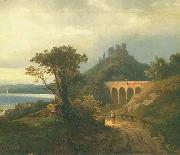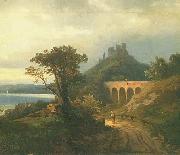
|
Olivier, Johann Heinrich Ferdinand
|
|||
|
|
|||
| German, 1785-1841 | |||
|
|
|||
|
Italian Landscape new5/Olivier, Johann Heinrich Ferdinand-424226.jpg Painting ID:: 19672 |
1830 Oil on canvas Oskar Reinhart Foundation, Winterthur. | ||
|
|
|||
|
Claude Lorrain
|
|||
|
|
|||
| French 1600-1682 Claude Lorrain Galleries In Rome, not until the mid-17th century were landscapes deemed fit for serious painting. Northern Europeans, such as the Germans Elsheimer and Brill, had made such views pre-eminent in some of their paintings (as well as Da Vinci in his private drawings or Baldassarre Peruzzi in his decorative frescoes of vedute); but not until Annibale Carracci and his pupil Domenichino do we see landscape become the focus of a canvas by a major Italian artist. Even with the latter two, as with Lorrain, the stated themes of the paintings were mythic or religious. Landscape as a subject was distinctly unclassical and secular. The former quality was not consonant with Renaissance art, which boasted its rivalry with the work of the ancients. The second quality had less public patronage in Counter-Reformation Rome, which prized subjects worthy of "high painting," typically religious or mythic scenes. Pure landscape, like pure still-life or genre painting, reflected an aesthetic viewpoint regarded as lacking in moral seriousness. Rome, the theological and philosophical center of 17th century Italian art, was not quite ready for such a break with tradition. In this matter of the importance of landscape, Lorrain was prescient. Living in a pre-Romantic era, he did not depict those uninhabited panoramas that were to be esteemed in later centuries, such as with Salvatore Rosa. He painted a pastoral world of fields and valleys not distant from castles and towns. If the ocean horizon is represented, it is from the setting of a busy port. Perhaps to feed the public need for paintings with noble themes, his pictures include demigods, heroes and saints, even though his abundant drawings and sketchbooks prove that he was more interested in scenography. Lorrain was described as kind to his pupils and hard-working; keenly observant, but an unlettered man until his death. The painter Joachim von Sandrart is an authority for Claude's life (Academia Artis Pictoriae, 1683); Baldinucci, who obtained information from some of Claude's immediate survivors, relates various incidents to a different effect (Notizie dei professoni del disegno). John Constable described Claude Lorrain as "the most perfect landscape painter the world ever saw", and declared that in Claude??s landscape "all is lovely ?C all amiable ?C all is amenity and repose; the calm sunshine of the heart" | |||
|
|
|||
|
Italian Landscape new3/Claude Lorrain-735444.jpg Painting ID:: 28456 |
mk60 Oil on canvas 29 1/2x39" | ||
|
|
|||
|
Johann Koler
|
|||
|
|
|||
| (8 March 1826, in Vastemõisa near Suure-Jaani, Viljandi County, Estonia - 22 April 1899 in St. Petersburg, Russia) was an Estonian painter. He is considered to have been the first professional Estonian painter. He distinguished himself primarily by his portraiture and to a lesser extent by his landscape paintings. Some of his most notable pictures depict the Estonian rural life in the second half of the 19th Century. Johann Köler was the seventh child born to a peasant family. Despite the poverty of the parents Köler managed to attend the elementary and the district schools in Viljandi. Then he attended a workshop of master painters in Cesis (then in Livonia). In 1846, Köler travelled to St. Petersburg to work as a sign writer, where his talent was soon discovered. From 1848 to 1855 Johan Köler studied drawing and painting at the St. Petersburg Imperial Academy of Arts. During 1857 Köler travelled to Paris via Berlin, later returned to Germany then travelled to the Netherlands and Belgium. In 1858, he travelled across the Alps to Milan, Geneva, Florence and Rome. There, he studied in a private academy and devoted his time to watercolor technique. In Rome during 1859 he presented his composition "Christ on the Cross". Answering the call of the St. Petersburg Academy of Arts, Köler returned to the city in 1861. From 1862 to 1874 he was a teacher of the Grand Duchess Maria Aleksandrovna, the daughter of Czar Alexander II of Russia. In 1869-1870, he worked as a lecturer at the St. Petersburg Academy of Arts. From 1886 to 1889 Johan Köler worked in Vienna, Nice and Paris. | |||
|
|
|||
|
Italian landscape new24/Johann Koler-746498.jpg Painting ID:: 74007 |
Johann Köler "Italian landscape". cjr | ||
|
|
|||
|
Johann Koler
|
|||
|
|
|||
| (8 March 1826, in Vastemõisa near Suure-Jaani, Viljandi County, Estonia - 22 April 1899 in St. Petersburg, Russia) was an Estonian painter. He is considered to have been the first professional Estonian painter. He distinguished himself primarily by his portraiture and to a lesser extent by his landscape paintings. Some of his most notable pictures depict the Estonian rural life in the second half of the 19th Century. Johann Köler was the seventh child born to a peasant family. Despite the poverty of the parents Köler managed to attend the elementary and the district schools in Viljandi. Then he attended a workshop of master painters in Cesis (then in Livonia). In 1846, Köler travelled to St. Petersburg to work as a sign writer, where his talent was soon discovered. From 1848 to 1855 Johan Köler studied drawing and painting at the St. Petersburg Imperial Academy of Arts. During 1857 Köler travelled to Paris via Berlin, later returned to Germany then travelled to the Netherlands and Belgium. In 1858, he travelled across the Alps to Milan, Geneva, Florence and Rome. There, he studied in a private academy and devoted his time to watercolor technique. In Rome during 1859 he presented his composition "Christ on the Cross". Answering the call of the St. Petersburg Academy of Arts, Köler returned to the city in 1861. From 1862 to 1874 he was a teacher of the Grand Duchess Maria Aleksandrovna, the daughter of Czar Alexander II of Russia. In 1869-1870, he worked as a lecturer at the St. Petersburg Academy of Arts. From 1886 to 1889 Johan Köler worked in Vienna, Nice and Paris. | |||
|
|
|||
|
Italian landscape new24/Johann Koler-888686.jpg Painting ID:: 75503 |
Johann Köler "Italian landscape". cyf | ||
|
|
|||
|
Pedro Weingartner
|
|||
|
|
|||
| (Porto Alegre, 1853 - 1929) was an important Academic painter of Brazil, and the first artist born in Rio Grande do Sul to win international praise for his work. Born to a family of German immigrants, he began his artistic career as an amateur, helped by his brother Inecio, who was a lithographer, and possibly also by painter Delfim da Câmara. Anyway, in 1878 he moved to Germany in order to study in the Grossherrzoglisch Badische Kunstschule, in Karlsruhe. There he became a pupil of Ferdinand Keller, Theodor Poeckh and Ernst Hildebrand. In 1880 Keller moved to Berlin, being followed by Weingärtner, who then enrolled in the local Academy. In 1882 he left Germany for France, studying in the Academie Julian under Tony Robert-Fleury and William Adolphe Bouguereau. Wrecked by financial issues, he thought of abandoning his studies, but such situation was reverted by supportive friends, including Baron of Itajube, who got for him a special scholarship from emperor Peter II upon Bouguereau's advice. Then he could further his education in Rome. Thereafter for many years he divided his time between Rio de Janeiro, Porto Alegre and Rome, traveling very often and being celebrated as one of the most important Brazilian painters of his generation. In Rio Grande do Sul he was a star. In 1920 he was back in Porto Alegre, where the remained until death. His fame declined from 1925 on, facing competition from new painters and changing tastes in local art. | |||
|
|
|||
|
Italian landscape new25/Pedro Weingartner-698575.jpg Painting ID:: 86130 |
Date 1917(1917) Medium Oil on panel Dimensions 13.7 x 23.4 cm (5.4 x 9.2 in) cjr | ||
|
|
|||
|
Also Buy::. For Following Paintings / Artists / Products, Please Use Our Search Online: |












